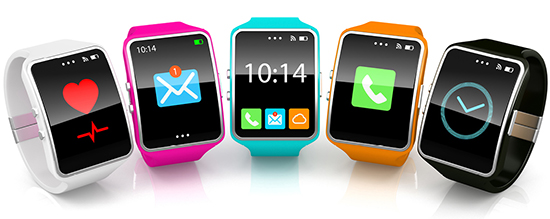Your Smartwatch
By Michelle Au and Andrew Bomback

Think of the stereotypical representations of medicine, as they might appear on a television show: the crisp white coat, of course, and the stethoscope dangling at the ready. Syringes and intravenous lines, maybe. An X-ray or a CT scan slammed theatrically into a
The wearable EKG offers the comforting weight of medicine itself, worn on the wrist like an amulet warding off evil. |
But any medical scene is incomplete without an electrocardiogram (EKG) machine running in the background, its jagged line tracing across the screen.
The EKG is the backbeat of many hospital scenes on television. Important medical things are happening here, it says.
To tap into that potent association, many private medical practices, urgent-care clinics, community hospitals, technology companies, and
Most of those images bear little resemblance to actual EKG tracings. The spikes and bumps generated for signs or emblems (like the logo of the daytime talk show The Doctors, for example) mostly amount to arbitrary peaks and valleys. They do not reflect the output of a human heart, healthy or diseased.
But accuracy might be less important than allegory. Like the white coat or the caduceus, the EKG has become talismanic, more valuable for the symbolism it provides than any diagnostic information it can convey.
Now that EKGs are making their way into smartwatches, their symbolic purpose could risk overtaking their medical one.
Wearable medical technology promises a new, better way to manage personal health.
Whether it’s Fitbits counting steps and calories burned, blood glucose monitors aiding insulin dosing for diabetic patients, or Bluetooth earpieces offering round-the-clock heart rate and body temperature tracking, wearable devices sell the promise of the coldly clinical made portably intimate.
Intermittent EKG monitoring, like that available in smartwatches, might seem like a small technological leap, putting what was once the sole purview of hospitals and doctor’s offices neatly around a consumer’s wrist.
But EKG monitoring is a little different from other, more discrete medical information.
Unlike devices that measure more cleanly numerical metrics—step counts or target heart rates or blood glucose levels—a wearable EKG display doesn’t give the user an easy sense of hitting targets or falling short.
Reading an EKG tracing is nuanced and interpretive, more art than math. A Fitbit gives you a number. An EKG paints a picture.
The 12-lead EKG, the gold standard of the diagnostic, measures the flow of current from 12 points on the patient’s body, offering a 360-degree view of the heart’s electrical activity. Its tracing reports the patient’s heart rate, rhythm, and regularity.
Because the various parts of the heart produce different shapes of electrical activity owing to their size and muscularity, the EKG can also detect which chambers are beating at what
The larger a muscle is, the stronger its electrical impulses, so the size of an EKG wave can also indicate whether parts of the heart muscle are enlarged or dangerously thickened.
The most urgent diagnostic use of the device determines the presence and location of cardiac damage due to decreased blood flow.
 |
|
|
Michelle Au (above) is an anesthesiologist at Emory Saint Joseph’s Hospital in Atlanta and Andrew Bomback is a
|
Areas of the heart getting less oxygen will show changes in their electrical conduction, and the 12-lead EKG provides real-time information: not just indicating whether a patient is having a heart attack, but also which coronary vessels are most likely blocked.
The 12-lead EKG can also detect the location of scarring left behind by prior, sometimes silent heart attacks. An EKG tracing will clearly show an area of dead heart muscle no longer conducting electrical signals. Dead meat
Still, there’s plenty that a snapshot EKG can’t do, including diagnosing intermittent problems with rhythm or changes that only occur with certain activities.
An EKG doesn’t capture the shape or function of the heart’s valves, nor can it diagnose precarious plaques in the coronary arteries that could signal heart attacks waiting to happen.
The fewer number of leads an EKG has, the less information it can give you.
A one-lead EKG, such as the kind that appears in some smartwatches, gives just a single vantage point. For the diagnosis of some cardiac abnormalities, that’s akin to solving one side of a Rubik’s Cube. A watch endowed with this kind of EKG feature likely won’t have a large public health impact.
By incorporating an EKG into smartwatches and their marketing, electronics makers use EKG to brand their watches in the same way that health care providers use EKG to establish trust in their clinics, or television shows use EKG to communicate medical professionalism.
An EKG feels weighty and complex, standing in for doctors and their expected acumen. Don’t worry, the purveyors of an EKG are communicating, we’ve got this.
The history of the EKG has always pitted cutting-edge medical advances against the placebo of quasi-medical reassurance.
The first electrocardiograph was developed in 1901 by Dr. Willem Einthoven, a Dutch cardiologist.
Einthoven’s original “string galvanometer” weighed about 600 pounds, required five skilled
The machine was virtually impossible to use and its readouts equally difficult to interpret, yet it became a near-immediate sensation in the medical world, and Einthoven won the Nobel Prize in Medicine for the contribution.
The modern 12-lead EKG is more streamlined, and the future (if the current crop of wearables is any indication) promises further downsizing of the device, with even more potential for
Whether it is room- or wrist-sized, the EKG has always attempted to record the size, shape, and timing of the heart’s intrinsic electrical impulses, giving people the ability to review, track, and potentially intervene on its functions.
Put differently, the EKG tries to reframe the heart as a machine that can be monitored and, to some extent, mastered.
Shrinking and wearing an EKG is a symptom of technology’s drive to subsume health and wellness, and it renews a belief in humanity’s mastery of the heart, that most important muscle.
EKGs might start to seem capable of producing meaning on their own, instead of producing pictures to be interpreted by medical professionals.
That aligns the single-lead, wearable EKG with the set designer’s intentions for the symbol.
The EKG—especially the 12-lead device—offers real diagnostics, but not nearly as often as its traces convey the symbology of health.
The wearable EKG offers the comforting weight of medicine itself, worn on the wrist like an amulet warding off evil, whether it ever gets used or not.






